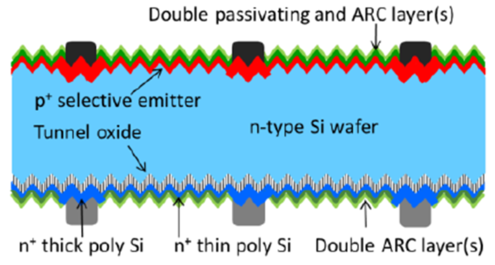Advanced n-Pasha
In the “Advanced n-Pasha” project the partners will research and develop a new, bifacial, n-type cell architecture based on passivated contacts and with a target efficiency of 22.5%. Combining passivated contacts with a bifacial front and rear contacted solar cell is an attractive way to improve the efficiency of existing n-type cells that are now in (pilot) production. Boundary conditions for the processes are low cost, reduction in silver consumption and ready to implement into industry. To assess the latter, the cell concept will be evaluated at two from the top 5 solar cell manufacturers: Yingli and Jinko Solar. The project result will be the architecture and processes the new bifacial n-type solar cell. This cell will feature a diffused, selective emitter combined with passivated contacts at the rear using tunneling oxide and poly silicon n+ layer. The metallization coverage will be reduced to around 5% at both front and rear, which in combination with adjusted poly-Si layer between the contacts, will enable a bifacial cell with rear response around 95% of the front. Due to the lower metal coverage as well as by implementing silver-less (parts of) the metallization, the total costs of the cell concept will be significantly reduced as compared to the current screen printed bifacial n-type cells such as n-Pasha. The total cost of ownership on module level will be reduced from 0.55 €/Wp now to <0.40 €/Wp in 2017.

Research objective
PVMD group brings in its expertise on passivating layers and integrating these layers in a working lab solar cell to evaluate the processes and to explore the efficiency limits of the n-type cell design. PVMD will also work on optical modelling to improve light management. The focus of the PVMD is on materials and solar cell devices. The PVMD group will contribute to the work package of (1) Light management on cell and module level : Light management of the whole module with all optically active layers will be studied in detail by modeling. Light scattering by metallization (within the module) and spacing between the cells will be taken into account. The effect of application of light scattering foils / coating on the module will be evaluated by modelling and by using test structures. (2) PVMD will study bifaciality aspects up to module level by modelling and validation of model and also research low absorbing poly-Si layers while maintaining conductivity on lab cells. For maximal Jsc the metal fraction needs to be reduced, for bifacial cells the rear metal fraction should be similar to that of the front. Target metal fraction reduction: 5% à 3% (front) and from 12% à <6% (rear). Additionally, the conductivity (mobility) and parasitic absorption of n+ doped poly needs to be balanced. Target bifaciality = 95%.
Advanced n-Pasha
Subsidy: TKI
Duration: 2016-2018
People involved: Dr. Olindo Isabella, Dr. Guangtao Yang

